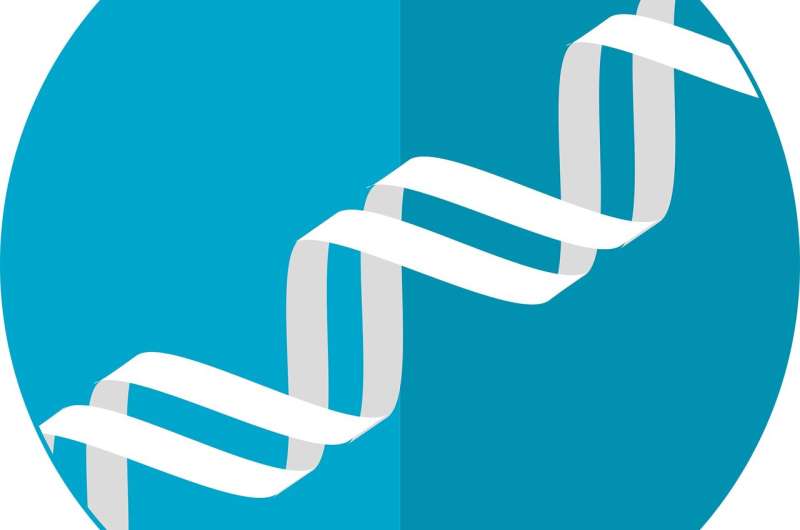

Scientists in the Perelman School of Medicine at the University of Pennsylvania have uncovered the molecular causes of a congenital form of dilated cardiomyopathy (DCM), an often-fatal heart disorder.
This inherited form of DCM—which affects at least several thousand people in the United States at any one time and often causes sudden death or progressive heart failure—is one of multiple congenital disorders known to be caused by inherited mutations in a gene called LMNA. The LMNA gene is active in most cell types, and researchers have not understood why LMNA mutations affect particular organs such as the heart while sparing most other organs and tissues.
In the study, published this week in Cell Stem Cell, the Penn Medicine scientists used stem cell techniques to grow human heart muscle cells containing DCM-causing mutations in LMNA. They found that these mutations severely disrupt the structural organization of DNA in the nucleus of heart muscle cells—but not two other cell types studied—leading to the abnormal activation of non-heart muscle genes.
“We’re now beginning to understand why patients with LMNA mutations have tissue-restricted disorders such as DCM even though the gene is expressed in most cell types,” said study co-senior author Rajan Jain, MD, an assistant professor of Cardiovascular Medicine and Cell and Developmental Biology at the Perelman School of Medicine.
“Further work along these lines should enable us to predict how LMNA mutations will manifest in individual patients, and ultimately we may be able to intervene with drugs to correct the genome disorganization that these mutations cause,” said study co-senior author Kiran Musunuru, MD, Ph.D., a professor of Cardiovascular Medicine and Genetics, and director of the Genetic and Epigenetic Origins of Disease Program at Penn Medicine.
Inherited LMNA mutations have long puzzled researchers. The LMNA gene encodes proteins that form a lacy structure on the inner wall of the cell nucleus, where chromosomes full of coiled DNA are housed. This lacy structure, known as the nuclear lamina, touches some parts of the genome, and these lamina-genome interactions help regulate gene activity, for example in the process of cell division. The puzzle is that the nuclear lamina is found in most cell types, yet the disruption of this important and near-ubiquitous cellular component by LMNA mutations causes only a handful of relatively specific clinical disorders, including a form of DCM, two forms of muscular dystrophy, and a form of progeria—a syndrome that resembles rapid aging.
To better understand how LMNA mutations can cause DCM, Jain, Musunuru, and their colleagues took cells from a healthy human donor, and used the CRISPR gene-editing technique to create known DCM-causing LMNA mutations in each cell. They then used stem cell methods to turn these cells into heart muscle cells—cardiomyocytes—and, for comparison, liver and fat cells. Their goal was to discover what was happening in the mutation-containing cardiomyocytes that wasn’t happening in the other cell types.
The researchers found that in the LMNA-mutant cardiomyocytes—but hardly at all in the other two cell types—the nuclear lamina had an altered appearance and did not connect to the genome in the usual way. This disruption of lamina-genome interactions led to a failure of normal gene regulation: many genes that should be switched off in heart muscle cells were active. The researchers examined cells taken from DCM patients with LMNA mutations and found similar abnormalities in gene activity.
A distinctive pattern of gene activity essentially defines what biologists call the “identity” of a cell. Thus the DCM-causing LMNA mutations had begun to alter the identity of cardiomyocytes, giving them features of other cell types.
The LMNA-mutant cardiomyocytes also had another defect seen in patients with LMNA-linked DCM: the heart muscle cells had lost much of the mechanical elasticity that normally allows them to contract and stretch as needed. The same deficiency was not seen in the LMNA-mutant liver and fat cells.
Research is ongoing to understand whether changes in elasticity in the heart cells with LMNA mutations occurs prior to changes in genome organization, or whether the genome interactions at the lamina help ensure proper elasticity. Their experiments did suggest an explanation for the differences between the lamina-genome connections being badly disrupted in LMNA-mutant cardiomyocytes but not so much in LMNA-mutant liver and fat cells: Every cell type uses a distinct pattern of chemical marks on its genome, called epigenetic marks, to program its patterns of gene activity, and this pattern in cardiomyocytes apparently results in lamina-genome interactions that are especially vulnerable to disruption in the presence of certain LMNA mutations.
Source: Read Full Article